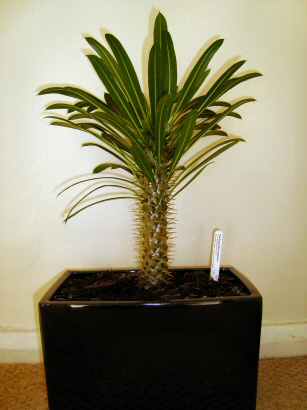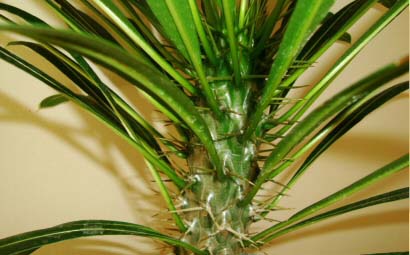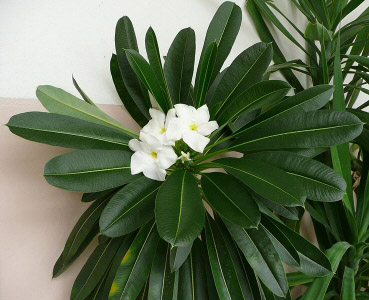





Despite it's common name of Madagascan Palm (or a Pachy to its fans) the Pachypodium is actually a succulent and therefore more closely related to cacti than palms.  It hails from Madagascar and because it has leaves growing around the crown this combination gives rise to the common name of Madagascan Palm.
It hails from Madagascar and because it has leaves growing around the crown this combination gives rise to the common name of Madagascan Palm.
Another house plant that Dr Hessayon describes as "unusual rather than attractive" and on this occasion because it looks a bit like a dieting pineapple (yes, you did read that right) we're going to agree. It may not be the most popular plant to stumble across in the average nursery or garden shop, but for anyone who likes a quirky easy going indoor succulent this could be your perfect match.
The swollen stem grows upwards with the leaves surrounding the crown gradually falling and then growing new ones as it ages. All parts of Pachypodium contain a latex sap which is poisonous, although even if you do have pets this may not be a total deal breaker because the plant protects itself by way of tough hooked spines that will deter even the most curious cat. The leaves are fair game for possible gnawing though, so unless they are sitting high up on a tall plant and therefore out of the way, you will have to think carefully before purchasing.
 There are several species, although the easiest and the most likely one you will come across is Pachypodium lamerei. They are sometimes confused with the Adenium (Desert Rose) but Pachypodium rarely flowers in cultivation and when compared side by side they are quite distinctive and different looking.
There are several species, although the easiest and the most likely one you will come across is Pachypodium lamerei. They are sometimes confused with the Adenium (Desert Rose) but Pachypodium rarely flowers in cultivation and when compared side by side they are quite distinctive and different looking.
Light
Always pick the sunniest spot you have.
Watering
A common myth about succulents is that they do not need much water
A common myth about succulents is that they do not need much water. It's true they will survive with little water, but they won't thrive if you treat them this way. Water your Pachypodium liberally in the Summer months whenever the soil dries out. In Winter water only sparingly.
Humidity
Unimportant.
Feeding
The Pachypodium is not a heavy feeder, so you will only need to fertilise a few times a year at most. As always only do it when the plant is in active growth.
Temperature
Warm. No lower than 10°C / 50°F in Winter.
Repotting
They take considerable time to outgrow their pots, however you may choose to repot your Pachypodium if it starts to wobble or topple from becoming top heavy. A standard soil mix is fine, but if you want to be extra safe add a little bit of grit to improve drainage. You can do it at anytime of the year, however take care when you do it because the spines can be painful if you grab the stem in the wrong way.
Propagation
Courageous readers may like to try and remove then pot up the offsets that are eventually produced around the base. However it's very difficult for the average houseplant owner to do this successfully.
Speed of Growth
This is a slow growing plant. However if you water well and provide good light in Summer you will notice more growth at this time of the year.
Height / Spread
Natively it can reach staggering heights, although In cultivation it's much more restrained. After many (and we do mean many) years the stem could reach upwards of 4ft / 1.2m in height and up to 24in / 60cm in diameter.
Flowers
 Flowering of the Madagascan Palm is rare indoors because the plant needs to reach maturity and tall heights first. There are always exceptions of course and if you do achieve flowers they will be white, numerous and star shaped.
Flowering of the Madagascan Palm is rare indoors because the plant needs to reach maturity and tall heights first. There are always exceptions of course and if you do achieve flowers they will be white, numerous and star shaped.
Anything else?
Pachypodium is a very adaptive house plant, it will take a wide range of temperature and light changes and adjusts accordingly. Our instructions above will help you grow a good specimen, but even if you treat it badly from time to time it should stay alive for quite a long time.
Copyright © www.100flowers.win Botanic Garden All Rights Reserved